There are three primary operations in the casting process which utilize natural gas fired equipment. In the first process, aluminum ingots and/or clean aluminum scrap are heated to around 650°C where the aluminum melts. In the second step, the molten aluminum is then transferred to a holding furnace where the molten aluminum is alloyed and degassed. If needed, then heated to the casting temperature of approximately 750°C. In the final step, the molten aluminum is then transferred via a ladle or tundish to the preheated die or mold.
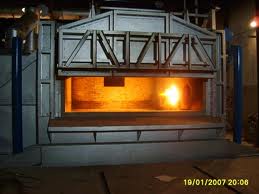
Reverberatory
Reverberatory furnaces heat the aluminum to melting temperatures with direct fired wall-mounted burners. The primary mode of heat transfer is through radiation from the refractory brick walls to the aluminum, but convective heat transfer also provides additional heating from the burner to the aluminum. Reverberatory furnaces are available with capacities ranging from up to 150 tons of molten aluminum. Typical aluminum reverberatory furnaces have melting efficiencies of 15%-39%. Recuperation can also enhance reverberatory furnace efficiencies by 10%-15%, but also adds to maintenance costs. The advantages provided by reverberatory aluminum melters is the high volume processing rate, and low operating and maintenance costs. The disadvantages of the reverberatory aluminum melters is the high metal oxidation rates, low efficiencies, and large floor space requirements.
Ladles
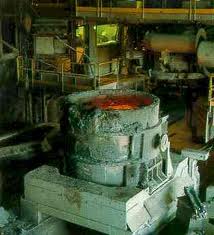 Ladles used to carry and pour molten aluminum need to be preheated prior
to loading to minimize the thermal shock and damage to the refractory
brick. Old practices used inefficient open gas pipes to heat the ladles.
This practice has been largely replaced by efficient ladle preheating
systems utilizing sealed covers, combustion controls, and even recuperation.
Most developments have been large steel mill sized ladles (up to 400 tons),
but recent developments have focused in foundry sized ladle (1 to 10 tons)
preheating stations which are used to preheat more than one ladle.
Ladles used to carry and pour molten aluminum need to be preheated prior
to loading to minimize the thermal shock and damage to the refractory
brick. Old practices used inefficient open gas pipes to heat the ladles.
This practice has been largely replaced by efficient ladle preheating
systems utilizing sealed covers, combustion controls, and even recuperation.
Most developments have been large steel mill sized ladles (up to 400 tons),
but recent developments have focused in foundry sized ladle (1 to 10 tons)
preheating stations which are used to preheat more than one ladle.
Electric Reverberatory
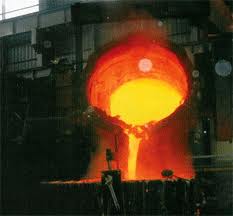 Electric reverberatory furnaces are used primarily as holding furnaces
and and are seldomly used as aluminum melters. These furnaces are refractory
lined vessels using resistance heating elements mounted in the furnace
roof above the hearth. These furnaces are used for smaller melting applications
where limitations on emissions, product quality, and yield are of high
priority. Advantages over gas fired reverberatory furnaces include low emissions,
low metal oxidation, and reduced furnace cleaning. Disadvantages include
high fuel costs, low production rates, higher capital costs, and frequent
replacement of heating elements.
Electric reverberatory furnaces are used primarily as holding furnaces
and and are seldomly used as aluminum melters. These furnaces are refractory
lined vessels using resistance heating elements mounted in the furnace
roof above the hearth. These furnaces are used for smaller melting applications
where limitations on emissions, product quality, and yield are of high
priority. Advantages over gas fired reverberatory furnaces include low emissions,
low metal oxidation, and reduced furnace cleaning. Disadvantages include
high fuel costs, low production rates, higher capital costs, and frequent
replacement of heating elements.
Gas Fired Crucible
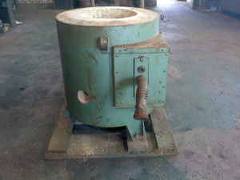 Crucible furnaces are small capacity, indirect aluminum melters/holders
typically used for small melting applications or exclusively as a holding
furnace. The aluminum is placed or poured into a ceramic crucible which
is contained in a circular furnace which is fired by a gas burner. The
energy is applied indirectly to the metal by heating the crucible. The advantages of crucible furnaces are their ability to change alloys
quickly, low oxidation losses, and their low maintenance costs. Disadvantages
include low efficiency (as low as 12%), high emissions, and size limitations.Energy efficiency can be improved by 50% by adding a ceramic matrix recuperator
to the exhaust system to recover waste heat for preheating the combustion
air.
Crucible furnaces are small capacity, indirect aluminum melters/holders
typically used for small melting applications or exclusively as a holding
furnace. The aluminum is placed or poured into a ceramic crucible which
is contained in a circular furnace which is fired by a gas burner. The
energy is applied indirectly to the metal by heating the crucible. The advantages of crucible furnaces are their ability to change alloys
quickly, low oxidation losses, and their low maintenance costs. Disadvantages
include low efficiency (as low as 12%), high emissions, and size limitations.Energy efficiency can be improved by 50% by adding a ceramic matrix recuperator
to the exhaust system to recover waste heat for preheating the combustion
air.
Sand Reclamation
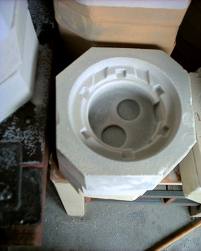 Higher costs of sand, transport, and disposal make sand reclamation economically
viable. In thermal reclamation, the binder is removed by heating the sand
to about 1500 degrees F using natural gas burners. Several types of furnaces
can be used for this purpose: rotary kilns, multiple hearth furnaces,
and fluidized bed. Thermally reclaimed sand actually has better properties
for casting than new sand: higher thermal stability, minimized weight
shrinkage, and better uniformity of grain structure.
Higher costs of sand, transport, and disposal make sand reclamation economically
viable. In thermal reclamation, the binder is removed by heating the sand
to about 1500 degrees F using natural gas burners. Several types of furnaces
can be used for this purpose: rotary kilns, multiple hearth furnaces,
and fluidized bed. Thermally reclaimed sand actually has better properties
for casting than new sand: higher thermal stability, minimized weight
shrinkage, and better uniformity of grain structure.
Electric Crucible
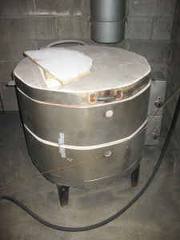 Electric crucible furnaces are similar to gas fired-crucible furnaces,
but utilize electric resistance-heating elements to heat the crucible
and melt the aluminum. Like their gas counterpart, electric crucible furnaces
are small and are typically used when alloy flexibility is the most important. Advantages provided by the electric crucible furnace is the near elimination
of emissions and low metal oxidation losses. Disadvantages include increased
fuel costs and size limitation.
Electric crucible furnaces are similar to gas fired-crucible furnaces,
but utilize electric resistance-heating elements to heat the crucible
and melt the aluminum. Like their gas counterpart, electric crucible furnaces
are small and are typically used when alloy flexibility is the most important. Advantages provided by the electric crucible furnace is the near elimination
of emissions and low metal oxidation losses. Disadvantages include increased
fuel costs and size limitation.
Induction
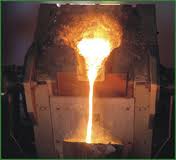 There are two general types of induction furnaces: channel and coreless.
Channel furnaces are used almost exclusively as holding furnaces. Channel
furnaces operate at 60 Hz where the electromagnetic field heats the metal
between two coils and induces a flowing pattern of the molten aluminum
which serves to maintain uniform temperatures without mechanical stirring.
Coreless furnaces heat the metal via an external primary coil. Coreless
furnaces are slightly less efficient than channel furnaces, but their
melt capacity per unit floor area is much higher. Coreless furnaces are
used mainly for melting of finely shredded scrap where they are most cost
competitive with gas-fired furnaces. Advantages of induction furnaces include high melting efficiency (50%-70%),
low emissions, low metal oxidation losses, and high allow uniformity due
to increased mixing. Disadvantages are primarily their high capital and
operating costs.
There are two general types of induction furnaces: channel and coreless.
Channel furnaces are used almost exclusively as holding furnaces. Channel
furnaces operate at 60 Hz where the electromagnetic field heats the metal
between two coils and induces a flowing pattern of the molten aluminum
which serves to maintain uniform temperatures without mechanical stirring.
Coreless furnaces heat the metal via an external primary coil. Coreless
furnaces are slightly less efficient than channel furnaces, but their
melt capacity per unit floor area is much higher. Coreless furnaces are
used mainly for melting of finely shredded scrap where they are most cost
competitive with gas-fired furnaces. Advantages of induction furnaces include high melting efficiency (50%-70%),
low emissions, low metal oxidation losses, and high allow uniformity due
to increased mixing. Disadvantages are primarily their high capital and
operating costs.
Tower
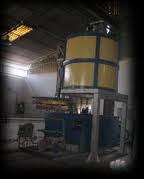 Tower furnaces are loaded from the top of a vertical tower with aluminum,
and burners at the bottom of the tower melt the aluminum. The primary
mode of heat transfer in tower furnaces is through convection by direct
impingement of the burner on the metal in the lower section of the tower,
and by the combustion gases as they travel out the tower past the metal
charge. A variation of the tower furnace uses a grate system which lowers
the metal through four grates, gradually heating the charge through each
grate until on the fourth and final grate, the charge melts and falls
into the hearth. The advantages of the tower furnaces are high efficiency (40%-77%) and
low oxidation losses. The disadvantages of tower furnaces are their high
capital costs and the furnace size is restricted by height limitations.
Tower furnaces are loaded from the top of a vertical tower with aluminum,
and burners at the bottom of the tower melt the aluminum. The primary
mode of heat transfer in tower furnaces is through convection by direct
impingement of the burner on the metal in the lower section of the tower,
and by the combustion gases as they travel out the tower past the metal
charge. A variation of the tower furnace uses a grate system which lowers
the metal through four grates, gradually heating the charge through each
grate until on the fourth and final grate, the charge melts and falls
into the hearth. The advantages of the tower furnaces are high efficiency (40%-77%) and
low oxidation losses. The disadvantages of tower furnaces are their high
capital costs and the furnace size is restricted by height limitations.

An aluminum smelter consists of a large number of pots, steel containers lined with carbon, in which the electrolysis takes place; smelting is run as a batch process, with the aluminum metal deposited at the bottom of the pots and periodically drained off/ Power must be available